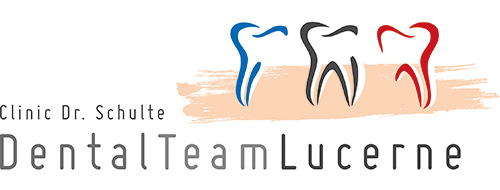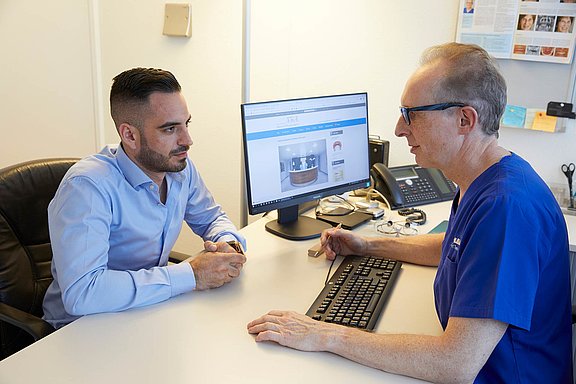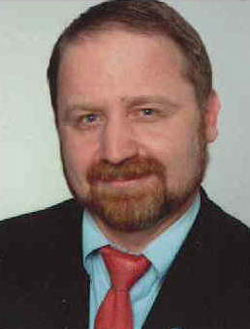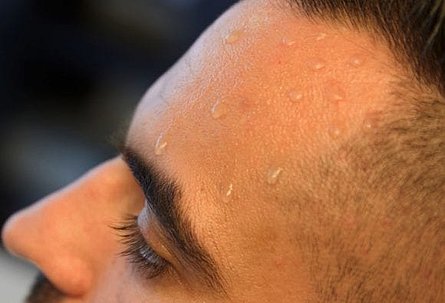
Dental phobia or the fear of seeking dental care is a widespread phenomenon. Even if the predominant part of the population regularly sees a dentist, between five and ten per cent suffer from such a strong fear of the dental office, that they only attend when the pain becomes too much to bear. This pronounced form of anxiety is known as dentophobia or dental phobia. Symptoms observed during dental treatment are tachycardia (rapid heartbeat), trembling, excessive sweating, choking, nausea, dropping blood pressure, to the point of circulatory collapse.
It may only be a small minority who suffer from this extreme form of anxiety. Nonetheless, according to surveys, almost 70% of the total population report having a distinctive fear of the dental office.
Download or print the complete article on one page: Dental Phobia
If you are interested in specific topics or if you want to read the chapter in sections, please choose from the following bullet points:
Who has fear of the dentist?
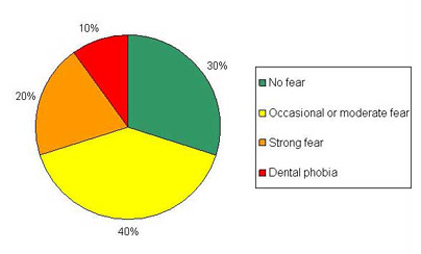
Potential sources of dental phobia
- Traumatising experiences during childhood or adolescence
- Scaring narrations from others, often from own parents
- General fear of pain
- Needle phobia (fear of injections)
- Fear of losing control
- Shame about the condition of the teeth
- Strong gag reflex during dental treatment (e.g. impression taking)
- Generalised phobias, psychosis and anxiety disorders
Frequently, no specific reason for the dental phobia can be established. Then it is the matter of a primordial fear like the fear of spiders (arachnophobia).
Consequences of dental anxiety
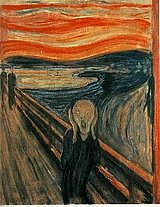
Dental fear often has a disastrous effect on both oral and general health. Inflammation and pain in teeth, gums, and jaw can undermine masticatory and digestive functions.Untreated periodontal diseases are considered a significant risk factor for cardiovascular disease and for diabetes.
One’s appearance also suffers and many dental phobia sufferers are ashamed of their poor teeth and the bad breath they cause. The patient’s often already damaged self-confidence takes a further blow. It is more than likely they cannot talk openly about their anxiety, having been laughed at in the past by friends or even the dentist. This creates a vicious circle that just makes the situation worse.
Our successful strategy against dental phobia: Why we don′t rely only on general anaesthesia
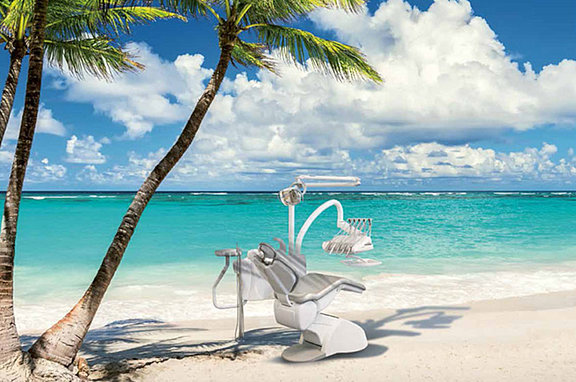
Our strategy against dental phobia is based on the following elements:
- Reduction of psychological stress
- Gentle, painless treatment
- Laughing gas treatment
- Conscious sedation treatment
- Treatment under general anaesthesia
Painless and stress-free treatment: How the first impression counts
Building a relationship of trust between patient and dentist is crucial to the success of therapy countering dental anxiety. The first step towards establishing contact is often a huge hurdle for the traumatised, anxious patient. The first impression garnered by such a patient upon arriving at the clinic is therefore all the more important. A stress-free, relaxed atmosphere before, during, and after treatment plays an important role here. That includes preventing unnecessary waiting times, a comprehensive and interesting range of reading material in the waiting room, unobtrusive music in a bright, modern surgery, where the typical smell of “dentist” is nowhere to be found.
When treating pronounced dentophobia patients, it makes sense to carry out early counselling in a neutral conference room without the presence of dental equipment, rather than in the surgery itself.
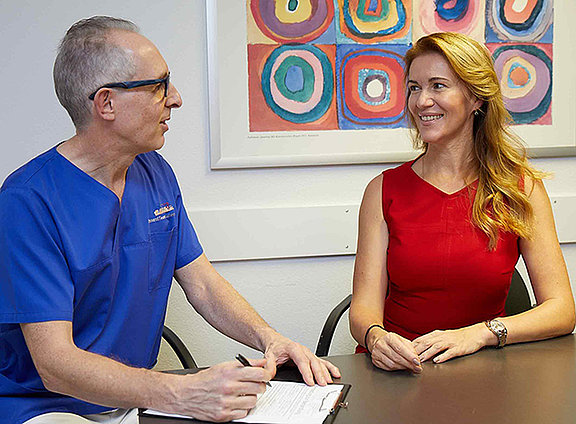
Gentle, painless treatment
Of course, a gentle, pain-free treatment technique is vital. And so it is that we dispensed with the traditional anaesthetic needle for treating individual teeth (fillings, crowns). Instead, the tooth is anaesthetized using the modern intraligamentary (Peripress) technique. Advantage for the patient:
- No inserting needles into the oral tissue
- Nearly painless administration
- Immediate effect
- Lips, cheeks and tongue remain unanaesthetized
The dental drill sound dreaded by many can be almost completely eliminated by specially shielded headphones playing relaxing music.
These measures alone are not enough to overcome the anxiety that many patients have built up over the years. Despite positive experiences (“it really doesn’t hurt”), the nightmare of a visit to the dentist still holds much of its horror.
Therefore, our dental office has facilities that provide anxiety-free treatment even in more difficult cases.
Case report 1 from our clinic
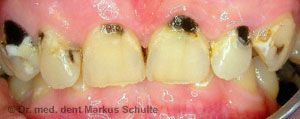
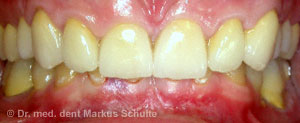
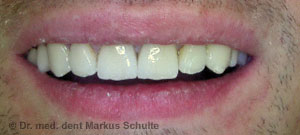
This 27-year-old man suffered from extreme dental anxiety stemming from traumatic childhood experiences. He had not been able to summon up the courage to visit the dentist for over 10 years.
He was in severe pain when he checked in at our clinic: deep carious lesions had already partially destroyed and disfigured his teeth, also resulting in the patient becoming socially isolated. The complete restorative work that was needed was carried out using nitrous oxide (laughing gas), to which the patient responded very well: the initial fear of the treatment sessions, some of which were lengthy, subsided appreciably. We were even able to carry out the last few procedures without using any nitrous oxide whatsoever.
Today, the patient has completely overcome his dental anxiety and undergoes treatment in our clinic in a perfectly normal manner.
Nitrous oxide analgesia (conscious sedation) - the renaissance of a proven method
The analgetic (painkilling) and sedative (calming) effect of laughing gas (chemical formula N2O, dinitrogen monoxide, nitrogen oxide) was discovered in the Nineteenth Century. It has since been used million-fold as an anaesthetic. Before introducing routine local anaesthetics, the analgetic effect of laughing gas was in the foreground. Today, its sedative anxiolytic (anxiety reducing) characteristic makes it an excellent tool for treating anxious patients. In the US and many other countries (England, Australia, Scandinavia), over 50% of all dentists regularly use laughing gas. The use of nitrous oxide has experienced a veritable renaissance in recent years in German-speaking countries, and more and more dentists are offering this safe and effective method of treatment.
How does conscious sedation with nitrous oxide work?
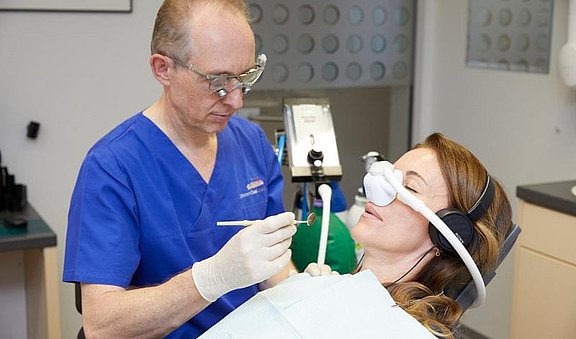
A small nasal mask releases a mix of oxygen and laughing gas. The effect begins after just a few breaths: From a feeling of lightness and relaxation, the patient drifts into a comfortable, trance-like state. Constantly addressable and in charge of the senses, the patient feels a desire to close the eyes. Anxiety and tension make way to a relaxed feeling of security. The custom-made headphones dampen the sound of the surgery. Suggestive, relaxing music supports and intensifies the hypnotic effect of the laughing gas. The patient is able to let go and follow pleasant thoughts. Time flies by.
At the same time, sensitivity to pain ebbs away, as does anxiety. Injecting anaesthetic in the mouth, for many patients otherwise a nightmare, is hardly felt any more. The typical feeling of nausea (gag reflex) experienced by many anxious patients (for example during impression taking) and the strong reflex to swallow, which often make treatment more difficult, are forgotten under sedation with nitrous oxide.
The dentist can vary the depth of sedation, adjusting to suit each patient individually. After treatment, the patient breathes pure oxygen for around 5 minutes. The effect of laughing gas is reversed and the patient leaves the dental office alone with a clear head. This ideal controllability gives laughing gas a decisive advantage over other sedation methods (oral or intravenous).
Read here an extensive experience report of a former anxious patient
Example I (Video): An anxiety patient tells
Also ideal for treating children

Laughing gas makes things better
Parents and dentist alike are faced consistently with the problem of children reluctant to have dental treatment. Many adults, even if they should know better, avoid essential dental appointments because of dental phobia; so how can appealing to a child’s reason be successful?
Laughing gas is an ideal tool in treating anxious children. However, the child must consciously be able to breathe through the nose (upward of six-seven years) and the nasal passage must be free. Furthermore, children treated with nitrous oxide should be reasonable enough to understand the necessity of their dental treatment. Thanks to the strong relaxing and anxiety-reducing effect of nitrous oxide, around 80% of children who would otherwise refuse normal dental treatment, can now be treated. Reducing gag reflex, nausea and the reflex to swallow while keeping complete receptiveness means treatment (for example fillings) can be carried out thoroughly. This is not always possible, especially with non-cooperative children (defensive reactions, persistently closing the mouth.). Often, the reliable laughing gas method can prevent the need for treatment under general anaesthesia.
More information about paediatric dentistry.
Risks and side effects
Laughing gas analgesia is an extremely safe method: With millions of recorded applications in the US, where around fifty-percent of all dentists use laughing gas, not one single serious incident has been reported. This method is not recommended, however, for patients with impeded nasal respiration, children under the age of three years or mentally handicapped people who cannot consciously breathe through the nose. In some rare cases, nausea or vomiting may occur as a side effect. Laughing gas is administered in our dental office under pulse oxymetric measuring. With this method, a finger sensor constantly measures the patients pulse and arterial oxygen saturation, as an extra safety precaution.
FAQs on Nitrous Oxide
There are hardly any medical contraindications to the controlled use of nitrous oxide; there are also no known allergies to it. However, current findings show that it is advisable to refrain from using nitrous oxide during pregnancy. Other patients who are also unsuitable are those whose nasal passages are not clear and those who have severe mental disabilities and cannot consciously breathe through the nose.
In some 85% of all patients suffering from anxiety, inhalation of nitrous oxide results in a clearly discernible reduction in anxiety. The method is less suited in cases of claustrophobia, as those suffering from this condition often find the nasal mask restrictive. Some patients are also afraid of losing control and thus find it difficult to relinquish any amount of self-control. Rather than using nitrous oxide, we opt to treat such patients under sedation (using sedatives) or – if necessary – under general anaesthesia.
We routinely administer a nitrous oxide test to our patients who suffer from dental anxiety; this is part of the examination that precedes the actual treatment. Thanks to our experience with this method, we can find out in a matter of minutes whether nitrous oxide treatment is suitable for you. If you feel that nitrous oxide works well for you, you will approach the first actual treatment session in a much more relaxed frame of mind!
Yes. Nitrous oxide is given primarily to relax and sedate the patient. But painful treatment still requires local anaesthesia to be administered in the mouth. However, the nitrous oxide that is administered results in the jab being perceived to be much less painful; sometimes, it is not noticed at all.
Yes. Unlike the sedatives that are administered in the form of tablets or injections and that remain in – and continue to have an effect on – the body for various periods of time, nitrous oxide is exhaled and completely eliminated from the body in a matter of minutes. In the USA, where nitrous oxide is used in millions of dental procedures, patients are even explicitly permitted to drive themselves home. Nevertheless, as a precaution, we advise our patients to use public transport.
Nitrous oxide is useful only if the child also appreciates, to some extent, the need to be treated. Miracles should not be expected of nitrous oxide and other sedatives when administered to those who refuse treatment outright. Often, the only method that is of benefit here is restorative work carried out under general anaesthesia. Our paediatric dental surgeon will be happy to provide advice.
Twilight sedation treatment using tranquillising agents
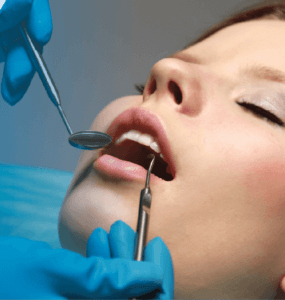
Sedation is the term given to a state of immobilisation or semi-consciousness brought about by medication (sedatives). Today, many medical examinations and procedures are carried out under sedation; these include gastroscopy and colonoscopy. Sedation is playing an increasingly important role in dentistry, too. There are a number of medicines that have a markedly calming (sedating) effect when administered intravenously as an injection, or orally, for instance in the form of tablets or drops. Today, these are primarily active ingredients from the so-called benzodiazepine group.
With these drugs, depending on the dose, a sedation can be achieved ranging from mild relaxation to a deep twilight sleep. A welcome side effect is that normally patients have little memory of the procedure after it is over. For the most part, even the gag reflex that proves problematic in some patients (e.g. when obtaining a mould impression) disappears completely under sedation.
Controlling the dosage of these sedatives requires special experience as the individual dosage can vary tremendously. The dosage needed to put some patients into a relaxed state can be enough to anaesthetize others. Unlike the conscious sedation with nitrous oxide, the sedative effect usually lasts longer than the treatment itself. The patient is not able to leave the dental office alone, and always needs the help of a companion.
The use of sedative medication in our dental office is restricted to surgical interventions as well as anxious patients for whom laughing gas is not effective enough.
Once treatment is complete, we provide after-care to our sedated patients in our recovery room, where they can rest in comfort.
FAQs on Twilight Sedation
Sedation using tranquillising agents is a proven and safe method of treatment; when administered correctly, complications are very rare. However, the general condition of the patient should be sound; for instance, there should be no evidence of severe cardiovascular or lung disease.
Sedation results in almost all patients experiencing a relaxed state in which they are free from anxiety. Even those patients who do not respond well to nitrous oxide because of their fear of losing control, for instance, can be sedated without any issues.
Yes, sedation ensures a deeper state of relaxation. A local anaesthetic is needed so that the patient does not experience pain. But when the patient is sedated, he/she generally does not notice the injection being administered at all.
No. The sedatives remain in the system for several hours, impairing your coordination and response capability. This is why you need someone to accompany you home; ideally, you should be driven home.
Sedation is problematic in children who are very anxious and uncooperative and who refuse to be treated with nitrous oxide. Their agitated state makes it possible for them to stash away extremely high doses of sedatives without manifesting signs of sedation. Once treatment is complete, they fall into a deep sleep that can last for several hours. For this reason, general anaesthesia is the method of choice for uncooperative children. Our paediatric dental surgeon will be happy to provide advice.
General anaesthesia: dental treatment in a state of deep sleep
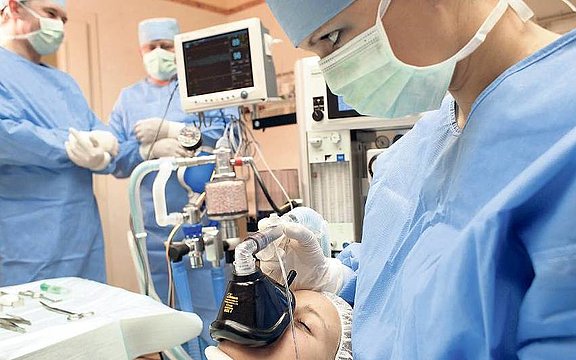
Particularly when major interventions or restorative procedures are indicated, many patients prefer not to be conscious during treatment. We can cater to this by carrying out treatment under general anaesthesia. We carry out treatment under general anaesthesia several times a week as a matter of course in our state-of-the-art operating theatre and recovery room. We are supported in our work by experienced narkose.ch anaesthetists, with whom we have been working successfully for over 15 years. General anaesthesia administered by an anaesthetist is now considered to be extremely safe, and complications are very rare.
We consider procedures carried out under general anaesthesia to be primarily indicated in the following:
- Major surgical and implant procedures
- Treatment of anxious patients who do not respond well to nitrous oxide or sedation or who express a preference for general anaesthesia
- Treatment of anxious and uncooperative children
FAQs on General Anaesthesia
Yes, if they do not present with severe systemic diseases. Prior to treatment, the anaesthetist ascertains whether or not additional diagnostics (e.g. ECG or blood count) are needed.
Unlike before, today there are virtually no problems with nausea after general anaesthesia. Just a short time after you wake up, you will feel well and relaxed, just as you would after a sound sleep.
No. You need someone to accompany you home; ideally, you should be driven home.
Treatment under general anaesthesia is the best solution for children who are very anxious and uncooperative and who refuse to be treated with nitrous oxide. This means that we can avoid traumatising our young patients and can prevent lifelong dental anxiety that can have well-known negative consequences. Our paediatric dental surgeon will be happy to provide advice.
Charges for anaesthesia are billed directly by our anaesthetists. You can expect to be charged between
approx. Fr. 800 and Fr. 1,200 per hour of anaesthesia.
Case Study 2 - Dental Fear
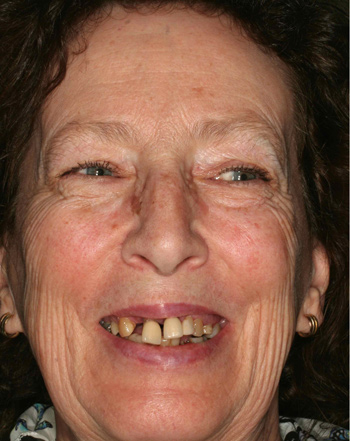
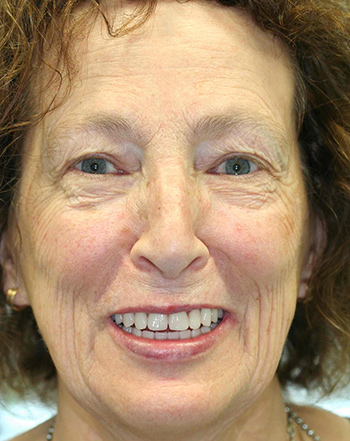
Ms Esther Burckhardt, Thun:
Our 67-year-old patient Ms Esther Burckhardt from Thun relates her experience: “I suffered from advanced periodontitis and could barely eat any more with my teeth being so weak. As a result of the inflammation, I had chronic pain and had to regularly take strong painkillers. I have suffered dentist-induced panic attacks since I was a child. This is why I have always put off thinking about implants. Because my teeth were so appallingly bad, in the end I stopped socialising altogether and felt increasingly isolated and depressed. When my daughter told me about the All-On-Four method, I had a glimmer of hope. Fixed teeth in one day: until now, this had just been a pipe dream. One day, I got my act together and decided to undergo a complete restoration procedure under general anaesthesia. Not for an instant have I regretted my decision to resolve my dental issues once and for all. My attitude towards life has changed completely now that my teeth are so strong and attractive; I feel much younger and more self-assured. And I can eat what I want once again without any worries. He who laughs last laughs best!”.
Our track record
The 2,000+ anxious patients treated in our clinic were asked to respond to a survey before, during and after treatment; we have used the results of this survey to compile statistics that allow us to review the success of our strategy to counter dental anxiety. This reveals that 74% of the patients treated experienced a significant decline in their original dental anxiety and 12% a perceptible decline. In just 14% of those surveyed was there absolutely no change. These data assure us that we are on the right path with our strategy to reduce dental anxiety.

